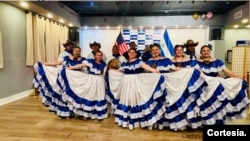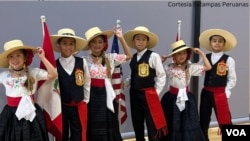Variety is the spice of life. This is demonstrated by the folklore groups in the Washington metropolitan area, one of the best examples of the work to consolidate the Latino presence in the United States, where more than 63 million Hispanics live, according to the Census Bureau.
And as a demonstration of this diversity, the first folklore cultural gathering in Northern Virginia will be held on Sunday, September 1, which will be an open window to the traditions, history and feelings of Latin Americans who seek to transmit their cultural legacy to future generations.
“Our mission is to preserve and promote Ecuadorian culture through music, through Ecuadorian dance itself,” he told the Voice of America Verónica Castro, who together with her sister Myri founded Raíces ecuatorianas, a folkloric group made up of around twenty people, added: “It all started two years ago as a family group.”
“We created the group out of necessity, because we saw that here in the Washington area, Ecuadorian folklore was not heard much. We have Peruvian, Bolivian, and Colombian groups, but there was no Ecuadorian group, and we started at home with our daughters and nieces, and little by little more Ecuadorian women joined, although now some men have also joined,” Verónica Castro said, laughing.
The Castro sisters say they feel “very proud and excited” to participate in the folkloric event, because they consider it an opportunity to show the world a little piece of their land and to do so they assure that they will give their best at the event, faithful to their motto “For the love of the Homeland.”
“The public will be delighted. The joy of sharing, of being transported to our small country while being in the US,” Myri Castro said.
Culture and social work
Douglas Quintanilla is the president of the Flor de Café Foundation, another folklore group with the same need to “rescue our folklore, our identity,” but at the same time carry out social work, he says.
Its members are mostly from the city of Barrios, in the department of San Miguel in El Salvador, and thanks to the teamwork they carry out, they can support their countrymen in their homeland in the areas of health and education.
“We chose to rescue our folklore because we realized that it was being forgotten and we wanted to do our part to preserve our identity and spread our true folklore,” Quintanilla told the VOA.
“Folklore is what connects us to our roots so we don’t forget where we come from, it’s what connects us to people,” added the representative of Flor de Café.
The first folklore meeting was born precisely to connect people and Latin American communities in the Washington area. The idea is that the event will become a true cultural mosaic. Its organizer, María Elena Guzmán, explained that the meeting will fulfill two functions: “the cultural diffusion of the peoples and to satisfy the need of a community that asks for it.”
“Latin American communities want to feel represented and at the same time involved so that together they can learn about different cultures. If we preserve our cultural roots, we will continue to survive under our essence. Creating knowledge about everything indigenous is what shows our culture and that is important here in the US because it is sowing in the new generations that love for what is ours,” she told the newspaper. VOAGuzmán, director of the Latin American Cultural Circle, an organization that seeks to promote cultural activities and Hispanic heritage in the United States.
For the love of children
There are many and varied folklore groups in the United States, but they are united by the same passion and the desire to not forget or let their customs and traditions die.
Most of these groups are made up of members of the same family who work to recruit more members and thus build a solid foundation that allows them to grow and expand. And this would not be possible if the children who will become future generations are not involved.
This is the case of José Luis Reyes, who created the José B. Reyes organization in honor of his father, who passed away five years ago. Reyes is of Mexican origin and says that he initially started out with the dance of Los Tecuanes, known as the dance of the jaguar.
“My father helped me a lot to be able to do this typical dance of our people here in the United States. My father also danced it when he lived in the town and he instilled in us that love for our own. In the same way, we continue with the dance to instill in the children, in the young people that love for our dances, for our folklore,” says Reyes.
“Nowadays, when I see my children and grandchildren dancing, I feel a great emotion, and I only hope that they continue with this tradition,” added José Luis Reyes.
According to the directors of these folklore groups, their main mission is to preserve their culture and heritage among children and young people and at the same time promote family unity in each rehearsal and in each performance.
“Many young people do not want to speak Spanish or do not know Mexico, and it is very important for us to let young people know where they come from,” Reyes says.
Edith Girón is another lover of her country’s traditional culture and is focused on serving the little ones. Because of her love for the marinera – a typical Peruvian dance – she decided to give life 12 years ago to Estampas Peruanas, a folkloric group that seeks to show the world the cultural richness of Peru with dances and traditions from the three natural regions that make up the South American country.
“Personally, I have always liked folklore and when my daughter was a child, we would go to marinera competitions and I loved seeing the children in their beautiful costumes. Then we got together with three friends and started to do performances at home with our children until we decided to form Estampas Peruanas,” recalled Girón, who said that her mission is to encourage children and teenagers to continue dancing and maintaining their roots.
Edith now works hand in hand with her daughter, who helps her with the choreography and looks for ways to encourage the participation of children and young people. They have even created a scholarship of 700 dollars that they give to each of their members when they leave the group at the age of 17.
“It is not much, but it is something symbolic to help them when they go to university. And it gives me great satisfaction to see that many of the young people who were part of Estampas Peruanas are returning and helping us with the younger ones. Our message is that it is very important for parents to instill these values in their children of love and passion for what is ours, because in this way we guarantee that our culture and traditions are transmitted from generation to generation,” said Girón.
Connect with the Voice of America! Subscribe to our channels YouTube, WhatsApp and to newsletter. Turn on notifications and follow us on Facebook, X and Instagram.
















Add Comment